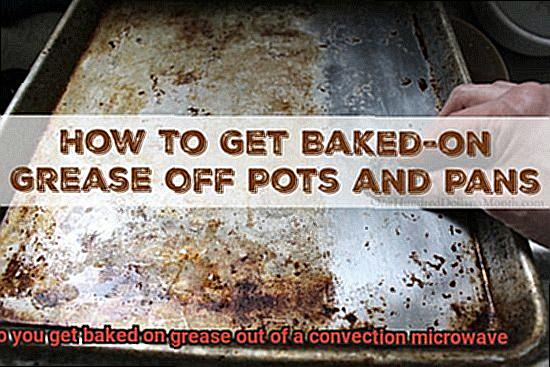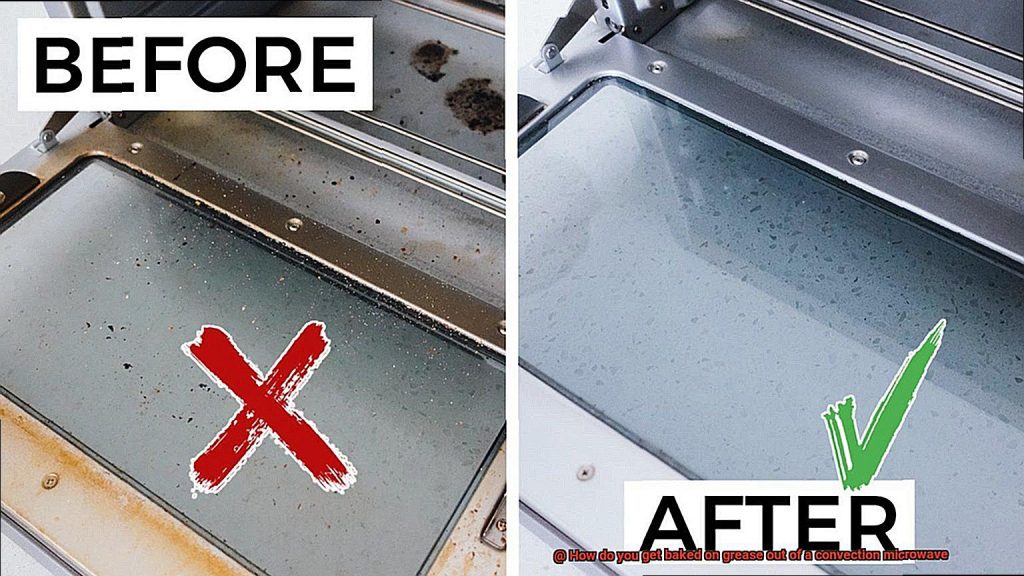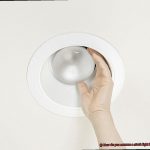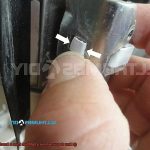Microwaves are a godsend when it comes to whipping up quick and easy meals. But, let’s face it – cleaning them is no fun at all. Especially when you open the door of your convection microwave and find a greasy, splattered mess staring back at you. Yuck. Baked-on grease can be a real pain to get rid of, leaving you feeling frustrated and defeated.
But fear not. We’re here to help you banish that stubborn grease once and for all. In this blog post, we’ll show you some nifty hacks and effective solutions that will make cleaning your convection microwave a breeze. Whether you prefer natural remedies or commercial cleaners, we’ve got you covered.
And that’s not all – we’ll also share some preventative tips to help keep your microwave looking spick-and-span for longer. Say goodbye to unsightly grease stains and hello to a sparkling clean appliance.
So if you’re tired of staring at a grubby convection microwave, then keep reading. Trust us – it’s easier than you think to restore your trusty kitchen companion to its former glory.
Contents
Unplugging and Cooling the Microwave
Cleaning a convection microwave is not only important for hygiene, but also for safety. Before you start the cleaning process, the first step is to unplug the appliance and allow it to cool down completely. This ensures that you won’t get burned while cleaning the interior and also prevents the microwave from turning on accidentally.
Once the microwave is cool, remove any loose debris or food particles from the interior with a soft cloth or sponge. Avoid using abrasive cleaners or scrubbers that could damage the surface. In case there is any baked-on grease or food residue inside, use a cleaning solution to help remove it. You can either use commercial cleaners specially designed for microwaves or make your own using ingredients like vinegar, baking soda, or lemon juice.
Mix the cleaner with water as per the instructions and apply it to the interior of the microwave using a cloth or sponge. Allow the cleaner to sit for a few minutes so that it can penetrate stubborn stains or grease buildup. Then use a clean cloth or sponge to wipe away the cleaner and any loosened debris, rinsing frequently in clean water to avoid spreading dirt and grime around inside.
Don’t forget to wipe down the exterior of the microwave with mild cleaner and a soft cloth to remove any fingerprints or smudges. Regular maintenance goes a long way in preventing baked-on grease from accumulating in the first place. Wiping down the interior after each use with a damp cloth or sponge will help keep your microwave clean and free from buildup.
In summary, here are some key steps to follow when cleaning your convection microwave:
- Unplug and let it cool down completely.
- Remove loose debris with a soft cloth or sponge.
- Use a cleaning solution for baked-on grease or residue.
- Wipe away cleaner and debris with a clean cloth or sponge.
- Wipe down exterior with mild cleaner and soft cloth.
- Regularly wipe down the interior after each use to prevent buildup.
Using Vinegar and Water to Remove Grease
We have an effective cleaning solution for you – vinegar and water. This powerful combo can cut through grease and grime, making it a popular choice among those who want to keep their kitchen appliances sparkling clean.
To get started, safety should always come first. Make sure your appliance is unplugged and cool to the touch before you begin cleaning. Once you’re ready, gather the following items: a spray bottle, white vinegar, water, cloth or sponge, and optional essential oils.
- Step 1: Mix one part vinegar with three parts water in a spray bottle. This solution will be your secret weapon against stubborn baked-on grease.
- Step 2: Spray the solution onto the interior of your convection microwave, focusing on areas with baked-on grease. Allow the solution to sit for a few minutes to let the vinegar break down the grease.
- Step 3: Grab a damp cloth or sponge and wipe away the grease and vinegar solution. Depending on how stubborn the grease is, you may need to repeat this process a few times.
- Step 4: Once all the grease is gone, rinse your cloth or sponge with clean water and wipe down the interior of the convection microwave to remove any leftover residue.
Pro tip: Vinegar has a strong odor that some may find unpleasant. To minimize this, add a few drops of essential oils like lemon or lavender to the vinegar and water solution before spraying it onto your convection microwave.
Remember to regularly wipe down your convection microwave after each use to prevent buildup. By using vinegar and water, you can ensure that your appliance stays clean and looking like new.
Using Baking Soda to Remove Grease
Baking soda is a popular and effective method for removing stubborn greasy stains.
To start, create a thick paste by mixing 2-3 tablespoons of baking soda with 1-2 tablespoons of water. Apply the paste generously to the areas of your convection microwave that have baked-on grease. Let the paste sit for at least 10-15 minutes, allowing the alkaline properties of baking soda to break down the grease.

Once the paste has sat for a while, use a damp sponge or cloth to gently wipe away the mixture. Repeat this process as needed until all of the grease is removed. Be sure to avoid scrubbing too hard, as you don’t want to damage the interior of your microwave.
After you’ve removed all of the grease, rinse your sponge or cloth thoroughly and wipe down the interior of your convection microwave with clean water. This will help remove any remaining baking soda residue and leave your microwave looking clean and fresh.
Why choose baking soda over other cleaning methods? For starters, it’s affordable and easily accessible, making it a great option for anyone looking to keep their convection microwave in good condition. Plus, it’s eco-friendly and won’t harm the environment or your health with toxic chemicals.
Commercial Cleaners for Tough Stains
While baking soda can work wonders, sometimes it’s just not enough. That’s where commercial cleaners come in. There are different types of commercial cleaners available on the market specifically designed to tackle tough stains like these.
Foaming cleaners are a popular option for those who want a cleaner that clings to the surface of the microwave. When sprayed on, it foams up and penetrates and breaks down grease and grime. Once the grime is broken down, it’s much easier to wipe away. However, be cautious while using this type of cleaner as it can be quite strong.
Spray cleaners are another quick and easy option for removing tough stains in your convection microwave. Simply apply it directly to the stain and wipe it away with a cloth or sponge. But just like with foaming cleaners, it’s crucial to read the instructions carefully as some spray cleaners may require gloves or other safety precautions.
It’s important to note that commercial cleaners can be caustic and harmful if not used properly, so always make sure to test them on a small, inconspicuous area of the microwave first before applying it to the entire surface. Additionally, be sure to follow the instructions closely to avoid any damage or safety hazards.
Regular Maintenance Tips to Prevent Buildup
Maintaining a clean convection microwave is crucial for efficient functioning and avoiding the buildup of stubborn baked-on grease. Here are five tips you can follow to prevent grease accumulation:
Wipe down after each use
After every use, use a damp cloth or sponge to wipe down the interior of your microwave. Pay special attention to areas where grease may have accumulated, such as the walls, ceiling, and door. This will prevent any spills or splatters from turning into baked-on grease.
Use a microwave-safe cover
When cooking messy foods like sauces or soups, cover them with a microwave-safe lid or cover. This will contain any mess and prevent it from sticking to the interior of your microwave. It’s also a good idea to use a plate or paper towel to cover food that tends to splatter.
Deep clean periodically
Periodically deep clean your convection microwave to remove any accumulated grease and grime. Start by removing removable parts like the turntable and racks, and clean them separately with warm water and dish soap. For the interior of your appliance, you can use a specialized microwave cleaner or a solution of warm water and vinegar.
Check and replace air filter
The air filter in your convection microwave helps trap grease and other particles, so it’s important to keep it clean. Regularly check the filter and replace it if it’s clogged or damaged. Follow the manufacturer’s instructions for cleaning or replacing the filter.
Use microwave-safe containers
When heating up food in your convection microwave, make sure to use microwave-safe containers. Avoid using plastic containers that may melt or warp and cause spills and messes inside the microwave.
Scrubbing the Interior with Non-Abrasive Materials
Cleaning the interior of a convection microwave can be a daunting task, especially when faced with stubborn baked-on grease. But fear not, as an expert in scrubbing the interior with non-abrasive materials, I have some tips and tricks to make this chore a breeze.
First and foremost, using non-abrasive materials is crucial to avoid damaging the surface of your microwave. Harsh chemicals such as bleach and abrasive materials like steel wool should be avoided at all costs. Let’s stick to gentle methods.
One effective option is to use a mixture of water and vinegar. This simple solution will create steam that helps loosen up the baked-on grease. Just mix equal parts water and vinegar in a microwave-safe bowl and heat it for several minutes until it boils and creates steam. Then, wipe away the mess with a soft cloth or sponge. This method is perfect for those who prefer natural cleaning solutions.
Another great non-abrasive method is to use mild dish soap and warm water. Mix a few drops of dish soap into a bowl of warm water, and gently scrub the interior of your microwave with a soft cloth or sponge. Remember to wring out excess water from your cleaning tool before using it on the microwave. This is an easy way to remove grease without using any harsh chemicals.
For tougher stains, you may need to let the water and vinegar mixture or soapy water sit in the microwave for several minutes before scrubbing. This gives the cleaning solution time to work its magic. And if there’s any remaining residue, try using a plastic scraper tool to remove it gently.
It’s important to note that abrasive materials can cause damage to your convection microwave and may even affect its functionality. So always stick to gentle cleaning methods.
Rinsing and Drying Thoroughly
However, you’re not done just yet. To maintain your microwave’s cleanliness and good working order, it’s crucial to rinse and dry it thoroughly.
Rinsing with warm water is the first step. After removing any visible debris or food particles, use a damp cloth or sponge to wipe down the walls, ceiling, and floor of the microwave. Pay extra attention to areas with stubborn stains, such as grease. These areas may require more than just a quick rinse, so don’t be afraid to use a bit of elbow grease.
Drying the interior completely is also important. Leaving any residual moisture behind can cause damage or allow bacteria to grow. Use a clean towel or paper towels to wipe away any moisture, or leave the door open and allow the interior to air dry for several hours.
Don’t forget about the exterior of your microwave. Use warm soapy water and a soft cloth to wipe down the outside of the microwave. This will remove any fingerprints, smudges, or other marks that may have accumulated over time.
By following these simple steps, you can ensure that your convection microwave stays clean and in good working order for years to come. Regular cleaning also helps prevent any unpleasant odors or flavors from lingering inside the microwave and affecting the taste of your food.
Disposal of Waste Materials
As an expert in this field, I have compiled some tips to help you dispose of waste materials properly and maintain the performance and longevity of your appliance.
Start by removing any loose debris from the microwave using a damp cloth or sponge. Avoid abrasive cleaners or scrubbers that could damage the interior of the microwave. Next, use a cleaning solution specifically designed for microwaves to break down any remaining grease or food residues. This will ensure that your appliance stays clean and hygienic.
Once you’re done cleaning, it’s important to dispose of any waste materials properly. Here are some things to keep in mind:
- Dispose of any paper towels, cloths, or sponges used during the cleaning process in a trash can or compost bin.
- Properly dispose of any cleaning solutions used during the cleaning process. Many microwave cleaning solutions are considered hazardous waste and should be disposed of according to local regulations. This may involve taking them to a hazardous waste collection site or contacting a professional hazardous waste disposal service.
- If you’re unsure about how to properly dispose of something, check with your local waste management authority for guidance.
KQw4GoVJ0G8″ >
Conclusion
Cleaning a convection microwave may seem like an overwhelming task, especially when it comes to baked-on grease. But don’t fret. There are several effective solutions and preventative tips that can make this chore a breeze.
To start, it’s important to unplug the appliance and let it cool down completely before removing any loose debris or food particles from the interior with a soft cloth or sponge. Then, tackle the baked-on grease with a cleaning solution like vinegar and water or baking soda paste. You can also opt for commercial cleaners for tough stains, but be sure to use them carefully and according to instructions.
Prevention is key when it comes to stubborn baked-on grease. Wiping down the interior after each use, using microwave-safe covers, deep cleaning periodically, checking and replacing air filters, and using microwave-safe containers are five tips that can help prevent grease buildup.
When scrubbing the interior of your convection microwave with non-abrasive materials like water and vinegar or mild dish soap and warm water, be sure to rinse and dry thoroughly afterward. This will help maintain cleanliness and good working order. Proper disposal of waste materials like paper towels or cleaning solutions is also important for maintaining the performance and longevity of your appliance.
By following these simple steps, you can ensure that your convection microwave stays clean and in tip-top shape for years to come.






